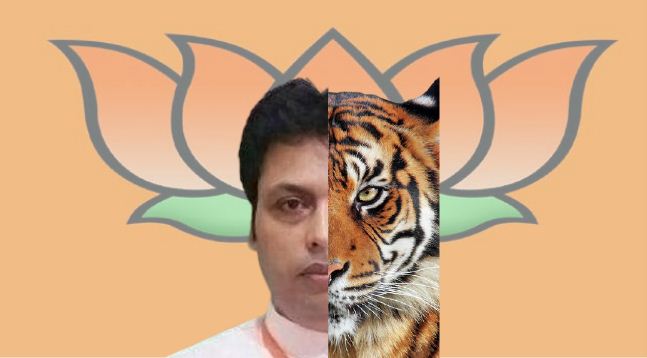In the recently held Municipal elections, Biplab Deb led Tripura BJP has registered a landslide victory over oppositions’ attempts to communalise the socio-political landscape in the state.
Biplab Deb thrashes Mamata’s dream in Municipal polls
BJP was victorious in 329 out of 334 total seats in 13 urban local bodies of the state. TMC which tried its best to pressure people to vote for them could only gather one seat for themselves.
The thrashing of TMC has surprised the usual ‘experts’, who were proclaiming that due to Bengali identity, TMC will win the elections. However, as it turns out, the people of Tripura, belonging to the Bengali identity do not relate to Mamata’s idea of Bengal anymore.
https://twitter.com/ItsShubhangi/status/1464895855878500364
West Bengal does not solely represent Bengalis
Today’s west Bengal is a minuscule portion of the erstwhile Bengal province ruled by the British The old Bengal province consisted of today’s West Bengal, Bangladesh, Odisha, Bihar, parts of Chhattisgarh, Jharkhand, and Assam. In 1905, Curzon decided to partition the state into a Muslim and a Hindu majority. However, the idea did not bode well for the Hindus and the state had to be reunified in 1911.
Tripura and its brief history of assimilation with India
Current Tripura as a significant Geographical entity came to the fore after the second partition of Bengal in 1947. The partition witnessed the erstwhile Bengal province getting fractioned into East Bengal and West Bengal. The Hindu-majority West Bengal became a state of India, and the Muslim-majority East Bengal (now Bangladesh) became a province of Pakistan.
Tripura, whose one part was known as plain Tripura and the other part was known as Hill Tripura was also bifurcated. While the Tippera district-erstwhile estate in the plains of British India went to the current day Bangladesh, the Hill Tripura remained under a regency council for nearly 2 more years.
In September 1949, Queen Kanchan Prabha Devi signed the instrument of accession to India, which led to Hill Tripura officially becoming part of India. In 1956, it was declared a Union Territory by the government of India, which meant that it was under the direct administration of the Indian president. In July 1963, an elected ministry was chosen to assist the President in running the administration. It was conferred full statehood in 1971 by the North-Eastern Areas (Reorganisation) Act, 1971.
People of Tripura always welcomed Bengalis in their state
Though Tripura was once known as a Tribal state, its rulers always welcomed the influx of Bengali intellectuals in the state. According to the 1951 census, the tribes of Tripura comprised 48.65 per cent of the state, while 51.35 per cent was occupied by various migrants, the majority of whom were Bengali Hindus. Among these Bengali Hindus in Tripura, a huge chunk of Hindus were those Bengalis who had migrated from East Pakistan after the partition of Bengal in 1947.
According to an estimate published in The Hindu, the four-year window between 1947-51 saw nearly 6,10,000 Bengalis migrating to Tripura. The Tripuraris kept welcoming Bengali Hindus in the state even after it came under the direct administrative control of India. The next phase of mass Bengali Hindu migration witnessed more than 1 million Bengali Hindus flocking to Tripura during the Bangladeshi war of Liberation in 1971.
Most of these Bengali Hindus are now permanently established in Tripura and are happily intermingling with the local population. According to the 2001 census, Bengalis now comprise more than 70 per cent of Tripura’s population.
Mamata Banerjee does not represent Bengal anymore
Since Bengalis are nearly 70 per cent of the state, it’s perfectly rational for Mamata Banerjee to think that TMC workers’ goondagardi in West Bengal can be copied in Tripura as well. The election strategists committed a fatal mistake by assuming that both Bengalis are the same. Mamata Banerjee’s West Bengal does not represent the Bengali identity which is famous for its suave intelligence. The influx of Bangladeshi Muslim refugees has ended up harming the Bengalis of West Bengal as Muslims comprise nearly 30 per cent of the state population. The Talibanisque violence by the nexus of TMC and Islamists has led to the diminishing status of original Bengalis and now they are a feeble section of the West Bengal demography.
Biplab Deb’s rise as a strong political leader armed with a solid backing of party cadres in the state has given a huge impetus to the original Bengali spirit to re-contribute towards the development of the state, eventually leading to the nation’s development. The spirit of original Bengalis like Aurobindo Ghosh and Swami Vivekanand has resurfaced thanks to the tit-for-tat treatment of goonda elements in the state. It’s time now for original Bengalis to assert their identities and end the fake dominance of modern west Bengal on the Bengali identity horizon.































